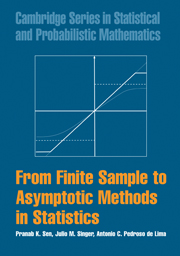Book contents
- Frontmatter
- Contents
- Preface
- 1 Motivation and Basic Tools
- 2 Estimation Theory
- 3 Hypothesis Testing
- 4 Elements of Statistical Decision Theory
- 5 Stochastic Processes: An Overview
- 6 Stochastic Convergence and Probability Inequalities
- 7 Asymptotic Distributions
- 8 Asymptotic Behavior of Estimators and Tests
- 9 Categorical Data Models
- 10 Regression Models
- 11 Weak Convergence and Gaussian Processes
- Bibliography
- Index
1 - Motivation and Basic Tools
Published online by Cambridge University Press: 05 June 2012
- Frontmatter
- Contents
- Preface
- 1 Motivation and Basic Tools
- 2 Estimation Theory
- 3 Hypothesis Testing
- 4 Elements of Statistical Decision Theory
- 5 Stochastic Processes: An Overview
- 6 Stochastic Convergence and Probability Inequalities
- 7 Asymptotic Distributions
- 8 Asymptotic Behavior of Estimators and Tests
- 9 Categorical Data Models
- 10 Regression Models
- 11 Weak Convergence and Gaussian Processes
- Bibliography
- Index
Summary
Introduction
Statistics is a body of mathematically based methodology designed to organize, describe, model, and analyze data. In this context, statistical inference relates to the process of drawing conclusions about the unknown frequency distribution (or some summary measure therefrom) of some characteristic of a population based on a known subset thereof (the sample data, or, for short, the sample). Drawing statistical conclusions involves the choice of suitable models that allow for random errors, and this, in turn, calls for convenient probability laws. It also involves the ascertainment of how appropriate a postulated probability model is for the genesis of a given dataset, and of how adequate the sample size is to maintain incorrect conclusions within acceptable limits.
Finite statistical inference tools, in use for the last decades, are appealing because, in general, they provide “exact” statistical results. As such, finite methodology has experienced continuous upgrading with annexation of novel concepts and approaches. Bayesian methods are especially noteworthy in this respect. Nevertheless, it has been thoroughly assessed that the scope of exact statistical inference in an optimal or, at least, desirable way, is rather confined to some special classes of probability laws (such as the exponential family of densities). In real-life applications, such optimal statistical inference tools often stumble into impasses, ranging from validity to efficacy and thus, have practical drawbacks. This is particularly the case with large datasets, which are encountered in diverse (and often interdisciplinary) studies, more so now than in the past.
- Type
- Chapter
- Information
- Publisher: Cambridge University PressPrint publication year: 2009

